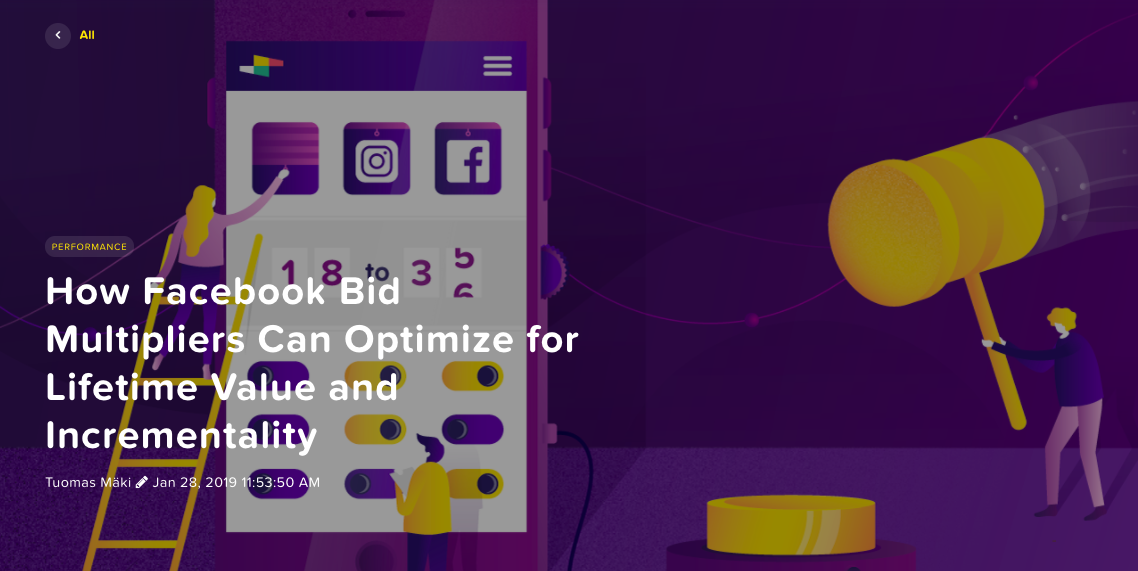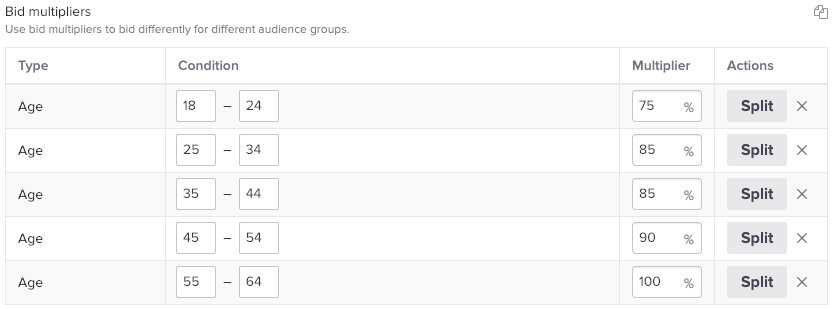Smartly.io: How Facebook Bid Multipliers Can Optimize for Lifetime Value and Incrementality
As covered in our recent Facebook Performance Trends for 2019 post, Bid Multipliers are a feature to watch as we have seen advertisers' focus shift first from website traffic to conversion optimization, then to Return on Ad Spend (ROAS), and finally to Lifetime Value and Incrementality.
Facebook’s newly rolled out feature Bid Multipliers is a valuable new feature to help advertisers move to this direction. We have run a series of tests on Bid Multipliers with our customers – and the feature systematically improves performance whenever there is a business case for using them.
Who should adopt Bid Multipliers?
Advertisers with Lifetime Value differences between user segments
Advertisers with incrementality differences between user segments
Advertisers without enough data to optimize for the final goal
E-Commerce advertisers with varying return percentages by audience segment
Meta-search services
Apps with a free trial
Apps with the revenue-generating event low in the funnel, such as on-demand services
How do Bid Multipliers work?
Bid Multipliers allow advertisers to define bids separately by audience segments without splitting them into different ad sets. The benefits are twofold:
Maximize the effectiveness of Facebook delivery algorithms - Learnings are collected within one ad set. The more data Facebook has to optimize, the better the results.
Account for additional information on audience segments – Advertisers might value a conversion differently based on the audience segment.
Setting up Bid Multipliers is easy - first, set an ad set level bid (e.g. $100 USD) - and then set multipliers for different audience segments (i.e. 80% for iOS, 100% for Android). The final bid is calculated as the percentage x the multiplier amount, i.e. $80 for iOS, $100 for Android. We provided an example by operating system, but this can be performed via platform, device, age, gender, location or even retargeting recency.
Use Cases for Bid Multipliers
Generally, we should vary bids in audience segments when we value a conversion differently in those segments. For example, if Lifetime Value is higher for iOS versus Android users, we would bid higher for iOS as we value those conversions more. However, we have identified three main use cases of Bid Multipliers, outlined below:
1. When Lifetime Value varies across audience segments
Audience segments might have different average Lifetime Values – e.g., users converted through different advertising platforms (Facebook, Instagram, Audience Network), or differing age, gender or geographic location. As shown in the example below, advertisers should bid higher for conversions in Instagram, which is shown as the highest-value platform. However, note that this is not a one-size-fits-all case and should always be researched beforehand, as other platforms might prove to have the highest LTV depending on the advertiser.
The advertiser bids higher for Instagram as, for them, users converted through Instagram have the highest LTV.
This example would also apply to users whom return products from e-commerce brands. When certain audience segments return more products, the value of a conversion is lower in these segments and advertisers should bid less for them.
2. When you are not able to bid for your final goal
This can happen for multiple reasons:
The final conversion event occurs on a partner’s web page with no advertiser’s pixel installed, e.g. Metasearch services
There is a delay before the final conversion event, e.g. Apps with a free trial
There aren’t enough conversion events to optimize for the final goal.
In each of the above situations, the conversion rate from advertiser’s bid goal to the final goal typically varies between audience segments. Facebook is great at optimizing delivery for the bid goal, but they cannot take into account what happens after that.
We encourage advertisers to analyze the conversion rates from their bid goal to final goal and find out if they should value conversions differently across segments.
The advertiser bids higher for Mobile than Desktop as they have seen that customers acquired through Mobile convert better for their final goal.
3. When incrementality varies across audience segments
Another valuable use case for Bid Multipliers is when there are incrementality differences between audience segments, i.e. when attributed performance is no longer an equal proxy of incremental performance between segments. Running a lift test and checking the lift breakdowns per user segment can help determine whether incrementality differences exist. Alternatively, multi-touch attribution solutions or conducting surveys, e.g. asking “How did you hear about us?” from new customers, can help achieve the same outcome.
To find out if Bid Multipliers based on incrementality add value, run a multi-cell lift test against a control campaign without them.
The advertiser bids more for older user groups where incrementality is higher.
To learn more about Bid Multipliers or how to choose multipliers for your business, drop us a line anytime at info@smartly.io.
We are excited to show how this feature can systematically improve your campaign’s performance. Mark your calendars and join us live for our Bid Multipliers for Mobile App and E-Commerce Advertisers webinar on March 20th at 10am GMT. Save your seat here.
Read the original article here



